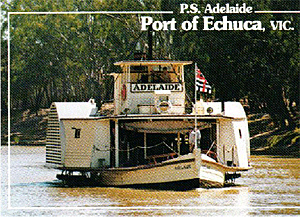Greg Blake
I thought you might like the following.
 I recently spent the day at Echuca a town in northern Victoria situated on the Murray River. Whilst there, I rode on one of the many riverboats that are a feature of the town. The boat was the PS Alexander Arbuthnot. She was an interesting vessel and was a very nice example of a steam powered wood fired paddle steamer. I must say I was in something like hog heaven standing on the vibrating deck and listening to the thump-thump-thump of the paddles hitting the water and the muffled pounding of the engine. The smell of the burnt wood, lubricants, smoke and all was wonderful.
I recently spent the day at Echuca a town in northern Victoria situated on the Murray River. Whilst there, I rode on one of the many riverboats that are a feature of the town. The boat was the PS Alexander Arbuthnot. She was an interesting vessel and was a very nice example of a steam powered wood fired paddle steamer. I must say I was in something like hog heaven standing on the vibrating deck and listening to the thump-thump-thump of the paddles hitting the water and the muffled pounding of the engine. The smell of the burnt wood, lubricants, smoke and all was wonderful.
I imagined myself on a gunboat pushing up some pestilential river in darkest Africa and I tell you it didn't take much to imagine it. The Alexander Arbuthnot's hull was built in 1923, her boiler in 1912 and her engines in 1887. I had a chat to the stoker and he filled me in on the ins and outs of handling a steam boiler. One interesting thing was that he said they did not use coal for fuel as it burned too hot [and was too expensive]. The heat from coal made the steel furnace casing flake so they avoided it. They used wood and preferred Redgum [a native Australian tree] as it reduced to hot coals unlike other hot woods that burned away to fine powder.
Speaking of heat I felt the heat near the boiler, it was bearable but still pretty fierce and I tried to imagine what it must have been like in an enclosed engine room in the tropics - hell I'd imagine! The whole Port of Echuca historical complex was excellent and included a section of the original river wharf that once measured one kilometre long [the biggest inland river port in the world at the time - the main cargo being wool]. There was also a very large collection of 19th and early 20th century steam tractors and even a steam bulldozer [a brutal looking piece of machinery that one]. All of these are in various stages of restoration. They also had an 1860 -70 vintage passenger railway carriage that was awaiting restoration. There was a sign on the door of the carriage saying to take note of the Spittoons in the corners.
There were about six riverboats operating the day I was there. Not all were steam powered but several were. The oldest vessel was the PS Adelaide built in 1866. I have attached a picture of her. The claim is she is the oldest working paddleboat in the world. Have any Heliographers heard of anything in the US or elsewhere older that is still operating? The flag on her bow is the Murray River flag flown by all the riverboats that worked the Murray River during the C19th.
I noticed a small paddle steamer for sale. I wonder how much they would want for it and if they would object to me mounting a Nordenfledt gun on her.
Nearby there was the Star Hotel with its cellar and secret escape tunnel for illegal drinkers, built after the hotel lost its license in 1897. Other interesting old buildings were scattered about. All worth a more lengthy look.
For anyone venturing to the Antipodes and with an interest in riverboats Echuca is certainly worth including on your itinerary.
Thanks for the letter and photo Greg. Makes me want to fly there and see these steamers myself, what a great trip!!! Not a Nordenfledt but a two pounder quick-fire gun on the bow. Well, may be a Nordenfledt on either side of the bridge.
I for one a very excited about this, as there are now three manufacturers that produce these figures - Copplestone, Cannon Fodder and Pulp Figures.
Back to The Heliograph # 130 Table of Contents
Back to The Heliograph List of Issues
Back to Master Magazine List
© Copyright 2002 by Richard Brooks.
This article appears in MagWeb (Magazine Web) on the Internet World Wide Web.
Other military history articles and gaming articles are available at http://www.magweb.com